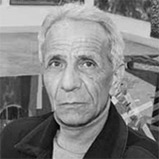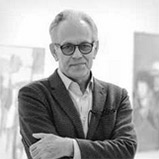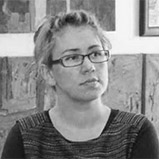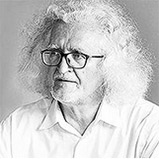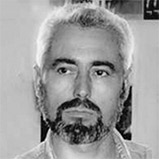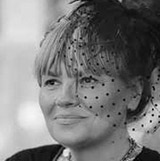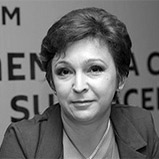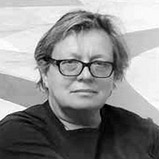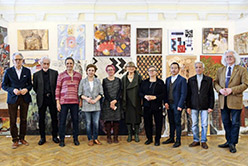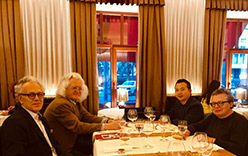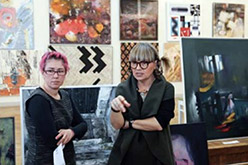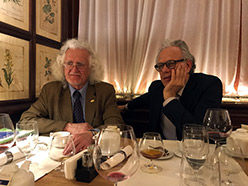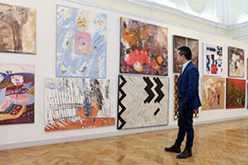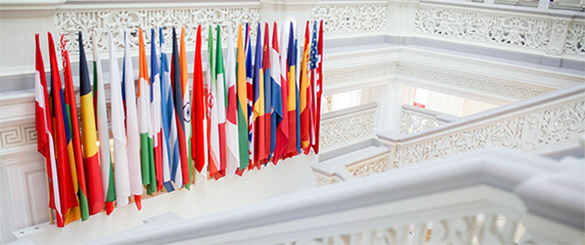
The International Painting Biennial 2019 – Moldova
Organizers:
The National Museum of Fine Arts of R. Moldova
The Union of Artists of Republic of Moldova
The Art Center AMPRENTE
Contacts:
31 August, 1989 str., nr. 115 Chisinau
MD-2012 Republic of Moldova
bip.chisinau(at)gmail.com
Phone: (+373) 79 54 85 11 (Curator)
Fax: (+373) 22 24 53 32
www.bipchisinau.com
The National Museum of Fine Arts of R. Moldova
The Union of Artists of Republic of Moldova
The Art Center AMPRENTE
Contacts:
31 August, 1989 str., nr. 115 Chisinau
MD-2012 Republic of Moldova
bip.chisinau(at)gmail.com
Phone: (+373) 79 54 85 11 (Curator)
Fax: (+373) 22 24 53 32
www.bipchisinau.com
Chairman of jury - Dr. Hb. Tudor Stavilă
The International Painting Biennial 2019
In current society, the command of technology in art is made of unique and subjective representations of a way in which artists interpret aspects of reality, offering simultaneously things outside of the technological realm, like sensitivity, creativity and sheer beauty, the painting itself remaining one of the accessible artistic media charged with symbols. This genre is outside the notion of time, encompassed in a gaze, it creates the illusion of a two dimensional simplified, reduced reality, so that the spectator can conserve their efforts.
The painting is color and sensation, an art with aesthetic, narrative and psychological functions. In order to objectively perceive its true artistic value, one must be familiarized with the period when it was produced, to witness the novelties brought to the art field and to artist’s biography. To discover the value that painting has for oneself, one must welcome subjectivity, and search within for the very range in tune with vibrations of the soul. In many instances, because of this, art critics, don’t always find common ground when it comes to many works, for everyone is attune to their own intrinsic answer.
The current International Biennial of Painting has convinced us of those things, establishing new evaluation criteria within the art domain. One could affirm that this year’s priorities where driven by conceptual essence, as a reaction to formalism centered on the Idea, the concept, and the artistic process are considered more significant than the final objective form of a creation.
Same as in the case of previous editions, the pre-selection of works was done by a qualified jury, with representatives from Romania, Belarus, Poland, Mongolia, and Republic of Moldova, who where tasked with choosing the upcoming layout, that will be comprised of 145 artist from Republic of Moldova, Romania, and other countries, with 152 works. The selection of participants also includes artists invited by Biennial’s curator, and General Director of The National Art Museum of Republic of Moldova, Tudor Zbârnea. It’s important to mention the variety of countries that will be represented. The 6th edition of the Biennial will host painters from: Armenia, Austria, Belarus, Cyprus, Czech Republic, Georgia, Germany, France, Ecuador, India, Israel, Indonesia, Italy, Lithuania, Poland, Romania, Russian Federation, Spain, Ukraine, Tunis, Turkey, and others.
As a result, the jury established main prizes awarded by partners of the International Biennial of Painting, 2019, as they follow: First Prize was awarded to Mister Lucian Hrisav (Romania), for his canvas „Column”, painted in 2018. The Second Prize was granted to Miss Ileana Ștefănescu (Romania), for the painting „Work in progress”, 2019, and Italian artist Constantin Migliorni, came in third place with his work „Rebirth”. The Ministry of Education, Culture and Research of Republic of Moldova, awarded the only prize claimed by a Moldovan artist, Victor Guțu, for his canvas entitled „He” (2017). The National Art Museum Prize went to Doris Dittrich, from Austria, for her painting „Dreamscape Florida” (2017).The Prize from Sturza Family Foundation, given by the Art Center „Amprente”, was awarded to Vasile Rața (Moldova/Romania), for his work „Untitled” (2017), followed by Daniela Grapă, a Romanian artist with her work „The Scream” (2018), who received a prize from the Romanian Institute of Culture „Mihai Eminescu” from Chișinău. By the end of exhibition period, first five works that received accolades from the select jury of the International Biennial of Painting, edition 2019, will be transferred into the collection of the National Museum of Art of Republic of Moldova.
Other participants of the current Biennial were granted Diplomas of Excelency, elaborated by The Ministry of Education, Culture and Research of the Republic of Moldova, amongst painters who were mentioned are: Giuliano Nardin with the canvas „Magician”, 2017, Romania, Dmitri Șibaev Stairs, 2019, Republic of Moldova, Marcela Vichrova from Czech Republic for her work „A dance in the forest”, 2018 and Terzis Nicos (Greece/Sweden) for his painting „My horizonts”, 2017. The biennial prioritized stylistic diversity of painting, but at the same pointed out main tendencies of European arts and came forth with means of creating images with conceptual messages, confirmed by the evaluating jury.
In this regard, the conceptual idea behind works created by Lucian Hrisav speak of his grievances, and his desire for a harmonious society, while Constantin Migliorini, by making a reference to Caravaggio’s painting „The Entombment of Christ”, presents us with an organic relation between the culture of today and our past. For Victor Guțu the present is filled with loneliness, which is also a motive apparent on Vasile Rața’s canvas, where only uncertain form prevails in world’s creation. Daniela Grapă’s painting, implies an intrinsic reminiscence of 20th century art, and exists in parallel with the renowned art piece by Edward Munch. In turn, Doris Dittrich in her depiction of despaired human figures over the background of the sea and the sky, as if presents a fragment of Japanese shadow theatre. The above mentioned authors, through varied artistic monologues, utilize in their works the same pictorial language, enriching it with new meaning and identity.
The selection of prize winners and aforementioned works of art, allows us to conclude, that unlike the guest participants of the Biennial, Moldovan artists remain tributary to aesthetic form and decorative notions.
Art critic, member of jury - Dr. Maria Bilașevschi
The International Painting Biennial 2019
Certainly, International Biennial of Painting Chișinău does not aim to cover, in a manner that is absolute, all the forms of pictorial expression, thought and technique, related to the two years that have passed since the last edition. Through the freedom and diversity that the event embraces from one edition to the next, it became more than an act of recovery and re-evaluation of the creations of contemporary artists but also an important means of synthesizing the configurations of the present visual arts by revealing the profile of those artists who break away from the norm and set new styles and trends.
Clearly, liberty can translate visually into conventional synchronicity or dogmatic prudence, but the general tone of the curatorial selection and jury assessment proves that the essential element, the one making the difference, lies in the artist’s personal meditation on the classic issues of visual thinking and the dynamism of innovation. More specifically, it is not through a particular formula that individuality is detected, but through its ability to reflect its own searches in a heterogeneous context.
The paintings exhibited at the Chișinău Art Museum represent primarily the human achievements, the technical ones resulting from an effervescent trans-disciplinary dialogue but also the conceptual ones pivoting around the answers that legitimize painting as a medium of change and not just aesthetic admiration.
In this sense, the jury’s mission in awarding the winners of this edition was not easy, the individual coordinates that function in the fair appreciation of an artwork had to take into account how “representative” the work is as a contemporary painting, but also have the ability to transcend the ideational and technical boundaries of painting per se.
In this respect, the First Prize winner, Lucian Hrisav, moves away from the traditional visual discourse by merging elements related to graffiti, street art, mural art at the intersection of several currents and intentions. The artist creates a new language, alchimizing elements of minimalist, cubist, pop, new media, in an artistic vision that rebuilds the totem-like object. At the intersection of the vertical rise of the city or the redundancy of communication and electric wires, Lucian Hrisav’s “Columns” appear to be multiplying according to an algorithm that does not want to mark the obvious serialism, but interprets the dependence of structures on themselves and on the background they are set in. By synthesizing, the artist presents the pure forms of the object translated into information, a self-sufficient semantic which is reconfigured independently in spatial and temporal forms. Clearly, the conceptual character is supported by colour expansions dispersed in converging rhythms in an attempt to explain the archetype of vision, while at the same time confirming that the essence of art is based on a primary element: the line.
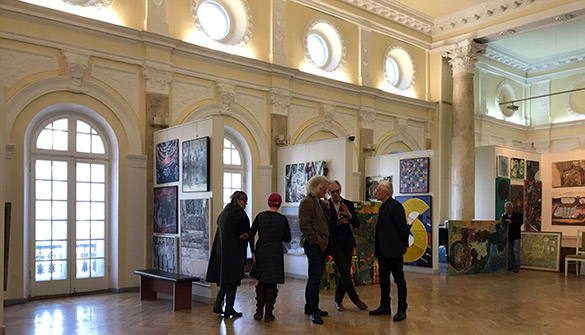
Jury–Team of The International Painting Biennial
Organizers: National Museum of Fine Arts of R. Moldova; Union of Artists of Republic of Moldova; Art Center AMPRENTE
The work of Ileana Ștefănescu, the winner of the Second Place Prize, illustrates what appears to be the growth rate of a rising urban environment, sometimes dimmed by opaque fragments or just intuited veins of construction. On a monotonous landscape without geo-spatial landmarks, the squares cut by the artist are being built one on top of another as sections of matter of what could be a physical space. Repetitive in ascension, but varied in colour, each of the forms emanates a nostalgia for existence. Nothing suggests the possibility of life behind the opaque windows, while space itself is agonizing at the passage of time, between uniformity and degradation. The desertification of the space-habitat translates into the loss of the individual’s presence, from macro to micro, this loss translates into stories interrupted by a perpetual transformation of the present. The work of Constantin Migliorini, awarded with the Third Place Prize, starts from the allegory of life and death of Caravaggio’s famous “The Deposition”. Cleverly grasping the characters and treating the forms as a warp of lines, threads, contours, signs that overlap in a fabric-painting, the artist creates a new narrative in which biblical figures, by the fragility suggested, appear to be immaterial beings, undetermined by a certain history. Moreover, the drama does not emerge from the hypostasis of physiognomy, but the psychological dimension and the accents that the artist imparts. The thin lines that precisely demarcate the Messiah’s body, intersect, juxtapose, to suggest the dematerialization of the physical body, a lightness of the being, while the textile inserts and the chromatic outline suggest the swinging of the characters between the earth and the sky.
A possible self-portrait replaces the traditionally associated image of St. Mary Cleopa, with extravagance and theatricality, proposing a new way of seeing the suffering, not from a traditional aesthetic perspective, but from an omnipresent, ironic and playful postmodern hypostasis at the same time. The arm of the angel above the primordial infant suggests a reverse reading of the genesis diptych, emphasizing the dichotomic character of the composition and the duality of the experiences.
Pain, supersaturation, crying, resignation, darkness, void, all these states, often overlapped, emerge from the portrait of Daniela Grapă, the winner of the Romanian Cultural Institute-Chișinău Award, through the concept and the intuitive colour palette, restricted to those colours that increase the drama, the contrast. In this state, emptied of consciousness or a sense of its own identity, the creature seems to be a particle of the unknown but also one of the earth, fragile and fearful. The choice to divide the character into two distinct halves starts from a belief that within the same “self” there exist not only ambivalent experiences, but also multiple potentials in a conjoined fusion. Duality relates not only to the other, but to the self itself, to the ambivalence of its own experiences and inner schisms. The artist performs a true anatomy of the soul, which is not the loss but the recapture, even if fragmented, of everything.
The artist Vasile Rață, a well-known name on the Romanian and European artistic scene, was awarded with the “Sturza Family Foundation” Award. Elements that seem to pertain to a metaphysical geometry that is intuitively outlined without digressions, essentially a visual translation of reactions to actual political, social and human realities are found in Vasile Rața’s works which carry a semantic load congruent with the whole artistic discourse. By filtering through abstractionism for the tension, the divisions, the manipulation, the contortions and the self-degradation, in essence the entire history of the Eastern space, the artist does not allow the idea to be seen without an overall knowledge of creation. At the boundary between the political aesthetics and the conceptual-qualitative depositions of the European cultural and artistic fund of the twentieth century, Vasile Rața’s work plunges between whole and void, both poles treated as receptacles, embracing or expelling matter. The general chromatic tone of the work does not betray any conclusion or intention of the artist to conceive of a post-post manifest (modernism, consumerism, communism), but to record the present, with its inherent syncopes.
The two awards of the National Art Museum in Chisinau were awarded to the artist Doris Dittrich and the artist Victor Guțu. “The Florida landscape”, as Doris Dittrich entitles her work, seems to contain an antithesis at a first glance, between the shadowy characters, with the back to the viewer, who seem to be waiting for something to happen and the fact that the opening is in fact a closure. The path to what could be a new destination is doubled obliterated, by the railing that separates them from the road and by the high voltage cables from which the birds look directly at the spectator. The manner in which the family is portrayed and the individual way in which each character expects a new destiny, but above all the fragmentation, emphasizes the solitude and disconnection of everyone from their environment, making the viewer play an active role in completing the narrative.
Drawing from the darkness of a narrative of the subconscious, with ramifications in a mythological neo-expressionism, Victor Guțu’s painting portrays a solitary figure, flanked by the emblems of a symbolic heraldry, while in background isolated fragments suggest that what we see seems to be the result a plague. Highlighting human and spiritual vanity, between dissolution and disorder, the ossified man, left as a relic of a lost cause, between two stubborn vultures that seem to guard the only aspect that reminds of life, a flower, appears as an artistic self-reflexive investigation. I’m confident that each participant and invited artist contributes to the success of the BIP Chisinau edition of this year, demonstrating that in fact there is no winning formula, even if, apparently, the common denominator lies in exploring the topics that have in forefront the individual, but in the adaptation and elasticity capacity with which artists each responds to current trends in society, politics and art.
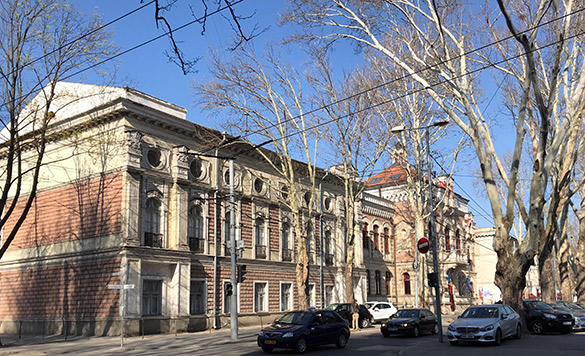
National Museum of Fine Arts of R. Moldova
–– The Catalog of The International Painting Biennial in Online ––

Jury–Team of The International Painting Biennial
Organizers: National Museum of Fine Arts of R. Moldova; Union of Artists of Republic of Moldova; Art Center AMPRENTE
Curator of the Biennial - Tudor Zbârnea
The International Painting Biennial 2019
In current society, the command of technology in art is made of unique and subjective representations of a way in which artists interpret aspects of reality, offering simultaneously things outside of the technological realm, like sensitivity, creativity and sheer beauty, the painting itself remaining one of the accessible artistic media charged with symbols. This genre is outside the notion of time, encompassed in a gaze, it creates the illusion of a two dimensional simplified, reduced reality, so that the spectator can conserve their efforts.
The painting is color and sensation, an art with aesthetic, narrative and psychological functions. In order to objectively perceive its true artistic value, one must be familiarized with the period when it was produced, to witness the novelties brought to the art field and to artist’s biography. To discover the value that painting has for oneself, one must welcome subjectivity, and search within for the very range in tune with vibrations of the soul. In many instances, because of this, art critics, don’t always find common ground when it comes to many works, for everyone is attune to their own intrinsic answer.
The current International Biennial of Painting has convinced us of those things, establishing new evaluation criteria within the art domain. One could affirm that this year’s priorities where driven by conceptual essence, as a reaction to formalism centered on the Idea, the concept, and the artistic process are considered more significant than the final objective form of a creation.
Same as in the case of previous editions, the pre-selection of works was done by a qualified jury, with representatives from Romania, Belarus, Poland, Mongolia, and Republic of Moldova, who where tasked with choosing the upcoming layout, that will be comprised of 145 artist from Republic of Moldova, Romania, and other countries, with 152 works. The selection of participants also includes artists invited by Biennial’s curator, and General Director of The National Art Museum of Republic of Moldova, Tudor Zbârnea. It’s important to mention the variety of countries that will be represented. The 6th edition of the Biennial will host painters from: Armenia, Austria, Belarus, Cyprus, Czech Republic, Georgia, Germany, France, Ecuador, India, Israel, Indonesia, Italy, Lithuania, Poland, Romania, Russian Federation, Spain, Ukraine, Tunis, Turkey, and others.
As a result, the jury established main prizes awarded by partners of the International Biennial of Painting, 2019, as they follow: First Prize was awarded to Mister Lucian Hrisav (Romania), for his canvas „Column”, painted in 2018. The Second Prize was granted to Miss Ileana Ștefănescu (Romania), for the painting „Work in progress”, 2019, and Italian artist Constantin Migliorni, came in third place with his work „Rebirth”. The Ministry of Education, Culture and Research of Republic of Moldova, awarded the only prize claimed by a Moldovan artist, Victor Guțu, for his canvas entitled „He” (2017). The National Art Museum Prize went to Doris Dittrich, from Austria, for her painting „Dreamscape Florida” (2017).The Prize from Sturza Family Foundation, given by the Art Center „Amprente”, was awarded to Vasile Rața (Moldova/Romania), for his work „Untitled” (2017), followed by Daniela Grapă, a Romanian artist with her work „The Scream” (2018), who received a prize from the Romanian Institute of Culture „Mihai Eminescu” from Chișinău. By the end of exhibition period, first five works that received accolades from the select jury of the International Biennial of Painting, edition 2019, will be transferred into the collection of the National Museum of Art of Republic of Moldova.
Other participants of the current Biennial were granted Diplomas of Excelency, elaborated by The Ministry of Education, Culture and Research of the Republic of Moldova, amongst painters who were mentioned are: Giuliano Nardin with the canvas „Magician”, 2017, Romania, Dmitri Șibaev Stairs, 2019, Republic of Moldova, Marcela Vichrova from Czech Republic for her work „A dance in the forest”, 2018 and Terzis Nicos (Greece/Sweden) for his painting „My horizonts”, 2017. The biennial prioritized stylistic diversity of painting, but at the same pointed out main tendencies of European arts and came forth with means of creating images with conceptual messages, confirmed by the evaluating jury.
In this regard, the conceptual idea behind works created by Lucian Hrisav speak of his grievances, and his desire for a harmonious society, while Constantin Migliorini, by making a reference to Caravaggio’s painting „The Entombment of Christ”, presents us with an organic relation between the culture of today and our past. For Victor Guțu the present is filled with loneliness, which is also a motive apparent on Vasile Rața’s canvas, where only uncertain form prevails in world’s creation. Daniela Grapă’s painting, implies an intrinsic reminiscence of 20th century art, and exists in parallel with the renowned art piece by Edward Munch. In turn, Doris Dittrich in her depiction of despaired human figures over the background of the sea and the sky, as if presents a fragment of Japanese shadow theatre. The above mentioned authors, through varied artistic monologues, utilize in their works the same pictorial language, enriching it with new meaning and identity.
The selection of prize winners and aforementioned works of art, allows us to conclude, that unlike the guest participants of the Biennial, Moldovan artists remain tributary to aesthetic form and decorative notions.
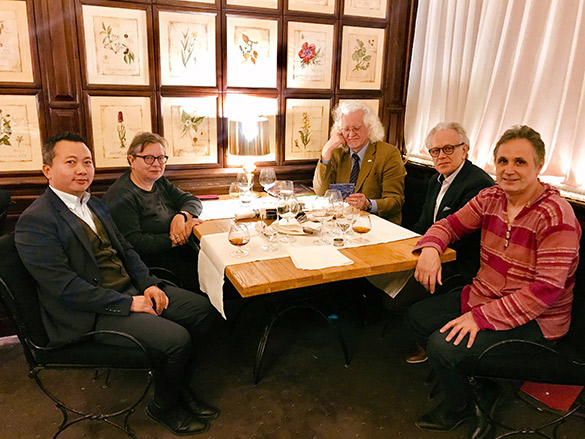
Jury–Team of The International Painting Biennial
Organizers: National Museum of Fine Arts of R. Moldova; Union of Artists of Republic of Moldova; Art Center AMPRENTE
–– The Catalog of The International Painting Biennial in Online ––
